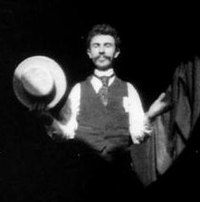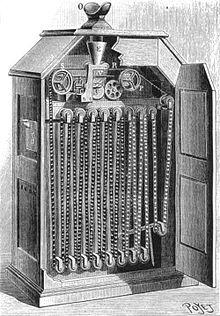William KL Dickson
William Kennedy Laurie Dickson (born August 3, 1860 in Le Minihic-sur-Rance , France , † September 28, 1935 in Twickenham , England ) was a Scottish inventor who worked in the American laboratories of Thomas Alva Edison, the cinetograph and the Kinetoscope , the first usable devices for recording and viewing moving images, developed.
Life
Dickson was born in Brittany to artistically gifted Scottish parents. His mother was a musician, his father was an artist, astronomer and linguist. Dickson himself was versatile too; so he was successful as a violinist, painter, cave explorer, photographer and inventor.
After the death of their father, the Dickson family returned to London in the late 1870s . It was there that Dickson first contacted the American inventor Thomas Alva Edison to apply for a position in his laboratories in Menlo Park , New Jersey . Edison refused, but when the family moved to the United States in 1881, Dickson was eventually hired by Edison in 1883. Within a few years, Dickson rose to become one of Edison's most important assistants.
In 1888 Dickson began to study the work of Eadweard Muybridge , Ottomar Anschütz and others on the recording and reproduction of "moving images". Edison envisioned a device similar to his phonograph for recording speech and music. Dickson therefore developed a prototype of the kinetograph in which the individual images could be recorded on a cylinder and played back from it. In November 1890 he made his first film, Monkeyshines , in which he filmed his assistant Fred Ott . The equipment chosen proved to be too complicated and impractical.
Instead, Dickson began working with celluloid film , which came on the market as roll film in the late 1880s. Dickson was not the first to use film strips for exposure, but he perfected the technical implementation by perforating the film strips. Dickson developed the kinetograph to record the images, while the viewing device was the kinetoscope , a peep box in which the developed film strips were illuminated by an electric light bulb. The first film made with a cinematograph was the Dickson Greeting strip, which lasted only a few seconds and in which the inventor bows and takes off his hat. The first public demonstration for a group of visitors in Edison's laboratories is recorded for May 20, 1891. On August 24th, a patent application for the kinetograph and kinetoscope was filed.
In the months that followed, Dickson improved the equipment and created the original form for normal film . He directed the construction of the first film studio, the so-called Black Maria , in which a number of films were recorded from 1893. The films were presented to a wider public at the Chicago World's Fair in 1893 . A year later, a salon with several kinetoscopes was opened in New York , where the paying audience could watch the films. One of the first films to be screened at the opening on April 14th was the Dickson-produced Blacksmith Scene , making it the first commercially available film. Around 1894, Dickson experimented with synchronized sound and thus produced the first sound film recordings , which at that time did not get beyond the experimental stage. The film was later restored by Walter Murch and released as Dickson Experimental Sound Film .
During this time there were repeated disagreements between Dickson and Edison. Dickson was convinced that projecting the images would be suitable for introducing a larger audience to the new invention, but Edison was not interested. He only changed his mind after the successes of the Lumière brothers with their cinématographe . When Edison hired a new manager for his company and he insisted that Dickson transfer all of his patents to Edison, the conflict deepened.
In 1895 there was a final break with Edison. Before Dickson left the company, he was secretly working for the Latham family . A little later he founded the American Mutoscope Company together with Herman Casler, Henry Marvin and Elias Koopman as a competitor to Edison's film studio. The Mutoskop was an improved viewing device patented by Casler, but Dickson had at least advised on the design (by which he had obviously betrayed Edison). The Biograph projector was developed to project the recorded images. The Mutoskop-Biograph system was far superior to Edison's projectors, but Edison had the better commercialization and the advantage that the use of 1⅜ ”wide film with 64 pairs of holes per foot was patented. At the beginning of the 20th century, however, the company gained in importance and achieved world fame with talents like DW Griffith .
In 1897 Dickson returned to London as head of the newly formed British Mutoscope and Biograph Company . He was not only active there as a manager, but also as a producer. So he filmed Pope Leo XIII in 1898 . in the Vatican . In 1899 he documented the Boer War in South Africa , about which he also wrote a book, The Biograph in Battle . In 1903 Dickson withdrew from the film business and worked as a self-employed electrical engineer . As an avid sports shooter, he trained snipers during the First World War . After the Great War, Dickson retired in Twickenham, where he died of cancer in 1935.
Despite Dickson's efforts, there was no longer any reconciliation with Edison. Edison, who made the groundbreaking work possible with his financial means and the technical and human resources of his laboratories, regarded Dickson as infidelity and ungrateful, but at the same time tried to erase Dickson's name from the history of the development of the cinematograph. By now, Dickson's importance is widely recognized, and in Scott Smith's book The Film 100 , Dickson topped the list of the 100 most important personalities of the first 100 years of film history.
Films (selection)
Edison Manufacturing Company
- 1890: Monkeyshines
- 1891: Dickson Greeting
- 1891: Newark Athlete
- 1891: Men Boxing
- 1892: A Hand Shake
- 1893: Blacksmith Scene
- 1894: Carmencita
- 1894: Dickson Experimental Sound Film
- 1894: Bucking Broncho
- 1894: Edison Kinetoscopic Record of a Sneeze (also: Fred Ott's Sneeze )
- 1894: The Barbershop
- 1894: The Boxing Cats
- 1894: Sandow
- 1895: Annabelle Serpentine Dance
American Mutoscope and Biograph Company
- 1896: McKinley at Home, Canton, Ohio
- 1896: Rip Van Winkle
British Mutoscope and Biograph
- 1899: King John
swell
- William KL Dickson, Antonia Dickson: The Life and Inventions of Thomas Alva Edison. Crowell, New York NY 1894.
See also
Web links
- William KL Dickson in the Internet Movie Database (English)
- Biography of Dickson (English)
- Biographs article on Dickson (English)
- The Dickson Experimental Sound Film
| personal data | |
|---|---|
| SURNAME | Dickson, William KL |
| ALTERNATIVE NAMES | Dickson, William Kennedy Laurie |
| BRIEF DESCRIPTION | British film pioneer |
| DATE OF BIRTH | August 3, 1860 |
| PLACE OF BIRTH | Le Minihic-sur-Rance , France |
| DATE OF DEATH | September 28, 1935 |
| Place of death | Twickenham , England |

